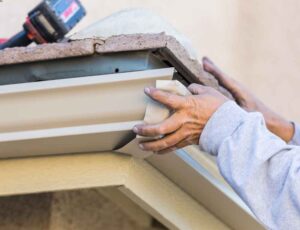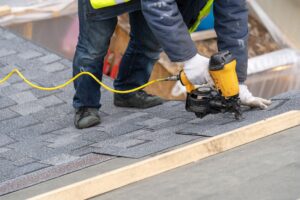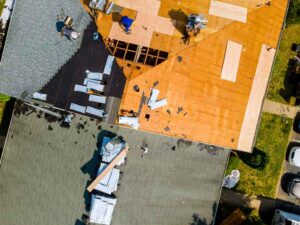There’s a saying in construction: what you don’t see can hurt you. That’s especially true in roofing—especially metal roofing during a Midwest winter.
If you own a home in Indianapolis, you already know that the combination of snow, wind, and ice is more than a seasonal nuisance. It’s the perfect storm for long-term roof damage—especially if your roof isn’t being checked and maintained regularly.
At Cornett Roofing Systems, we’ve worked on thousands of roofs across Indiana since 1991. We’ve seen the damage hail can do to metal panels, how freeze-thaw cycles weaken seams, and how fasteners start to back out after years of temperature swings. What looks like a strong roof in October can turn into a surprise repair by February.
So, we’re going to break it down: what kind of damage to look for, what to do about it, and why a little maintenance now saves a lot of headaches later.
Why Indiana’s Winters Are Hard on Metal Roofs
Metal roofing is one of the most durable materials available—and we manufacture and install it because it outperforms other systems in the long run. But no material is indestructible, and no roof is maintenance-free.
Here’s what your metal roof deals with every winter in Indiana:
- Freeze-thaw cycles: Snow melts during the day, then freezes at night. That moisture expands and contracts around seams and fasteners, loosening parts of the assembly over time.
- Hail impact: Small dents may not look serious, but they can compromise protective coatings. Once those coatings are breached, rust can begin underneath.
- Wind uplift: Gusty Midwest winds tug on flashings, ridge caps, and edges. If a panel or fastener is already loose, the wind will find it.
- Snow slides: Metal roofs naturally shed snow, but if it builds up too heavily or falls all at once, it can damage gutters or pull panels.
If your roof hasn’t been inspected in a few years—or if you’re not sure how well it held up after last winter—it’s worth taking a closer look now.
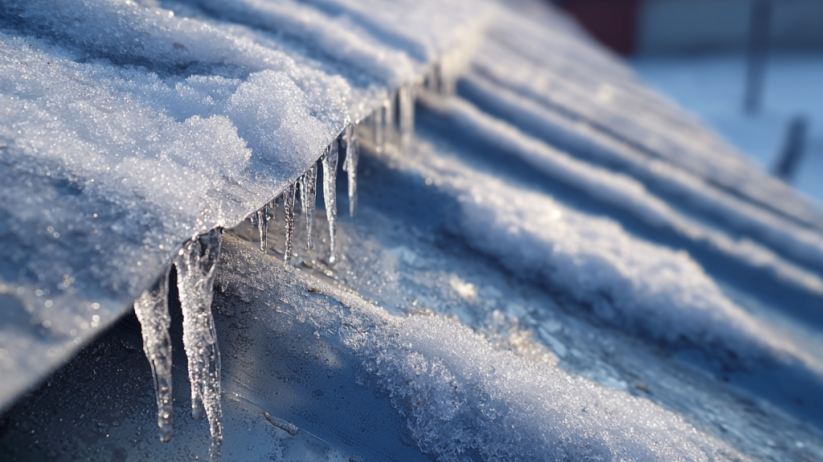
The Pre-Winter Metal Roof Checklist (For Indiana Homes)
If you want to keep your roof in peak condition heading into winter, here’s where to start:
1. Check Your Fasteners
Backed-out screws and loose clips are common on aging metal roofs. These are the weak points that cold air, wind, and moisture will exploit. Tighten or replace them as needed—especially along panel edges and near flashing.
2. Look at Flashings and Ridge Caps
These areas take the brunt of wind and thermal expansion. If flashing is bent, missing screws, or separating from the structure, it needs attention. Ridge caps can also shift or pull up under snow pressure.
3. Walk the Panels (Or Use a Drone)
We use drone-assisted inspections for this very reason—some damage isn’t visible from the ground. Look for hail dents, corrosion, or scratched areas where protective coatings are compromised.
4. Insulate and Ventilate
Proper attic insulation keeps heat from escaping into your roof deck, which reduces uneven thawing. Pair that with consistent ventilation at the soffits and ridge to keep airflow steady. The result? Fewer freeze-thaw stress cycles.
5. Clear What You Can
Remove fallen branches, trim overhanging limbs, and clean out debris. When snow starts falling, it’s best not to have organic material holding moisture against your roof surface.
6. Document the Condition
Take photos of panels, flashing, and gutters. If something changes during the winter—or if you need to reference damage later—having those photos helps.
If you’re planning out seasonal maintenance, our Year-Round Roof Maintenance Guide for Indianapolis Homeowners breaks it all down by spring, summer, fall, and winter—with practical checklists for every type of roof.
Not Sure What Wind Can Do to Your Roof?
Midwest storms don’t play favorites. Whether you’re facing hail, heavy snow, heat, or high winds, a roof built for today and tomorrow matters. For a full breakdown of metal roofing costs, material options, lifespan and performance in every season, check out our Premier Guide to Metal Roofing.
It’s a smart next step when you’re comparing options or thinking about upgrading to something that truly lasts.
Metal Roofing Materials and How They Hold Up to Midwest Weather
Not all metal roofs are created equal. The material, gauge, and installation method all factor into how well a roof stands up to hail, wind, and temperature swings.
Here’s what we install—and why:
- 24-gauge Galvalume Steel: Excellent performance, highly resistant to wind and hail, and offers long-term durability. Dents may be visible, but structure stays solid.
- .032″ Aluminum: Lightweight and rust-resistant, but slightly more vulnerable to denting unless reinforced with proper underlayment or panel design.
- Copper and Custom Metals: These roofs last a lifetime and look sharp doing it. They’re ideal for certain homes and neighborhoods, but the cost is higher and installation more specialized.
Knowing what type of roof you have—and how it was assembled—makes all the difference in seasonal maintenance and long-term performance.
Hail Damage Might Look Minor—But It Isn’t
We’ve inspected hundreds of roofs that looked fine from a distance… until we climbed up and got a closer look. Small hail dents can be more than cosmetic:
- They often occur in clusters where water and ice settle
- They crack or stress the coating, allowing corrosion to start
- They weaken the panel’s structural integrity over time
If hail hits your roof in late fall, those weakened areas can freeze and thaw all winter—widening gaps and causing unseen damage.
And here’s the other truth: most metal roof warranties require documented maintenance and inspections. Ignoring a small dent now could mean trouble later if you try to file a warranty claim.
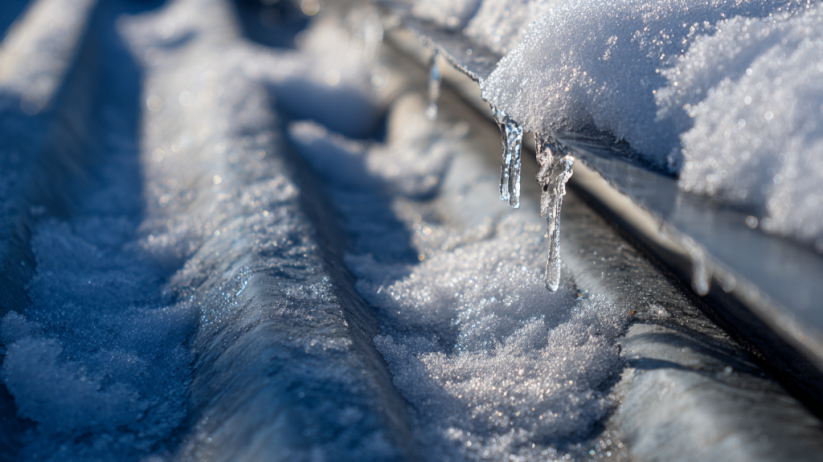
Frequently Asked Questions About Metal Roof Damage in Indianapolis Winters
Wondering how to tell if your metal roof is holding up—or whether that sound you hear is normal? You’re not alone. Indianapolis homeowners regularly ask us about hail damage, freeze-thaw effects, and what to look out for during extreme weather.
Here are the most common questions we hear, answered by the experts at Cornett Roofing Systems.
How often should I inspect my metal roof in the winter?
You should inspect your metal roof at least once or twice each winter. We recommend checking before the first major snowfall and again after any significant wind or hail event. These inspections help catch small issues—like loose fasteners or hail dents—before they become costly repairs.
Can hail really damage a metal roof?
Yes, hail can definitely damage a metal roof. Even small hailstones can dent panels, crack protective coatings, and stress fasteners—especially on older or improperly maintained systems. Left unaddressed, these dents can allow rust to form or cause structural wear over time.
What does it mean if I hear popping or creaking sounds in cold weather?
Popping or creaking sounds from your metal roof in winter usually mean the metal is expanding or contracting with temperature swings. This is normal to a degree, but excessive noise may indicate fasteners have loosened or panels are shifting more than they should.
Do you handle insurance claims for storm-related metal roof damage?
No, Cornett Roofing Systems does not handle insurance claims directly. However, we do provide detailed roof inspections and documentation that homeowners can use when filing claims with their insurance providers after hail, wind, or storm damage.
Can I still get help maintaining my roof if Cornett Roofing didn’t install it?
Yes, we provide roof maintenance services even if we didn’t install the original roof. Our team works with all types of roofing systems and can inspect, maintain, and repair your roof to keep it in top shape—protecting both your home and your warranty coverage.
Why We Built Cornett Roofing Systems Around Permanent Solutions
Back in the early days, our founder worked with asphalt shingles. After watching homeowner after homeowner replace them every 10–15 years, he knew there had to be a better way.
That’s why we shifted to metal roofing, and why we now manufacture our own panels in-house. Our focus has always been long-term durability—roofing systems that last 40+ years and perform better in the face of Indiana’s toughest weather. And this is also why our systems show dramatically less seasonal shifting and coating damage during freeze-thaw cycles compared to thinner, builder-grade metal.
It’s also why we back our work with warranties up to 50 years, and why we provide routine maintenance and inspection plans. You’re not just buying a roof. You’re investing in a system designed to last.
Ready for Winter? We’re Ready to Help.
If you’re not sure what shape your roof is in—or if you want peace of mind heading into another Indiana winter—schedule your inspection now.
We’ll give you the straight facts, show you any potential problems, and help you plan your next steps.
Serving Indianapolis, Greenwood, Carmel, Noblesville, Fishers, and communities across Central Indiana.
Call: (463) 240-1409
Email: [email protected]
Cornett Roofing Systems — Your Permanent Roofing Solution

